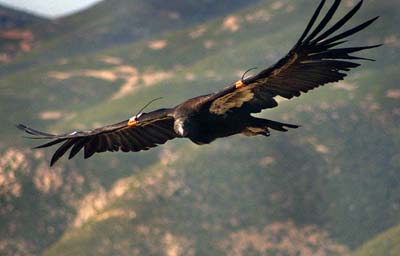
Now that a five-person team of Pinnacles National Monument
biologists recently returned from their trip to Argentina, they
plan to set up a sister park arrangement with Quebrada del
Condorito, an Argentinian national park, to boost condor
conservation efforts. The arrangement will feature an exchange
program for park officials and biologists.
HOLLISTER
Now that a five-person team of Pinnacles National Monument biologists recently returned from their trip to Argentina, they plan to set up a sister park arrangement with Quebrada del Condorito, an Argentinian national park, to boost condor conservation efforts. The arrangement will feature an exchange program for park officials and biologists.
Pinnacles Chief of Resource Management Denise Louie said the trip “was pretty amazing.” Both parks are part of efforts to protect and sustain populations of endangered condors.
“We made a lot of contacts and created a lot of ideas for collaboration,” she said, adding that the group “saw how similar the programs are and how we can learn from each other.”
The main goal of the trip was to start the footwork of establishing a sister parks program between Pinnacles and Quebrada del Condorito, which is in the Argentinian province of Cordoba. Along with the sister park arrangement, they hope the biologist exchange program will take off as well. Louie said their goal in 2009 is to bring a team of biologists from Argentina.
The areas surrounding Pinnacles and Quebrada del Condorito are quite similar in that the parks are surrounded by ranches and are topographically similar. Many of the ranchers, meanwhile, are working with the park to foster better condor awareness and survival, said Louie.
The two sides shared many ideas, such as how each group tracks information about their condors. Louie said Pinnacles checks the health of their condors by using a remote camera overlooking a perch that is also a scale. The Argentinians don’t have that same technology, but they do employ a Google Earth script to show condor movement.
Both of these strategies are examples of how the programs are exchanging ideas to help protect their species. “We are sharing information electronically and looking into how they might be able to use the same technology,” Louie said.
Even though they might not share the same technology, condor field biologist Scott Scherbinski said the Argentinian program is “amazingly similar to our program here.”
Scherbinski was one of two members of the five-person group to stay for an extended period of time. He left on Sept. 6 and stayed there until Oct. 24.
He also commented that in his travels throughout the country with the Argentinian staff, “it was amazing how open and friendly everyone was down there,” and he added that he was always invited into homes and often offered a meal.
Look for an expanded version in Tuesday’s Free Lance.









